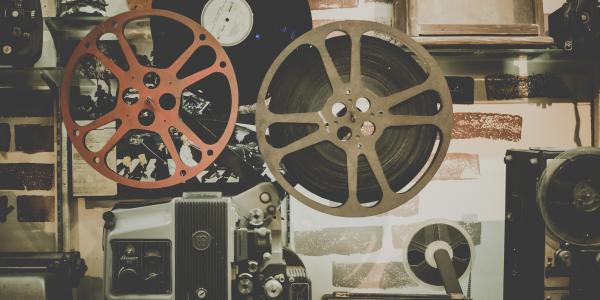Ever find yourself crying at a cheesy movie that you don't even like very much? Or catch yourself ducking and flinching during an action flick, even though you're perfectly safe in a movie theater, munching popcorn? Jeff Zacks, professor of psychological and brain sciences at Washington University in St. Louis, shares some of the reasons why. Zacks is author of Flicker: Your Brain on Movies.
Transcript:
Claire Navarro: Hello, and thank you for listening to Hold That Thought. I’m Claire Navarro. You know when you go see a movie, and you get so caught up in the story and the action that you forget about everything else for a couple of hours? It’s a sensation that most of us are familiar with, and that includes Jeff Zacks, associate chair of the department of Psychological and Brain Sciences here at Washington University in St. Louis. The difference between most of us and Zacks is that he has studied how our brains respond to movies. He wrote a book about it called Flicker: Your Brain on Movies. Zacks knows all about the tricks that film makers use to pull in an audiences eyes, brains, and emotions. But it doesn’t matter; he falls for it anyway.
Jeff Zacks: When I first started thinking about films, I used to freak myself out, because I would go into a theater and try to pay attention to all the stuff I had been thinking about in the film. Then I would experience what we know technically is called emersion—it just means that I got sucked into the movie—and I would realize 20 minutes later that I had missed all the stuff that I was trying to attend to.
CN: In today’s podcast, Zacks is going to help us understand some of the reasons why this happens –why it’s so easy to get mentally and emotionally wound up in movies. Part of the reason, he’s found, is that in our brains, there are a lot of similarities between how we react to moving images on a screen and how we react to real life.
JZ: The traditional formulation that was given to us by Wordsworth is that we have to suspend our disbelief to get lost in a poem or a story or a movie, but the thing that seems to be more true is that what we have to suspend is our belief, our engagement in the thing, because most of the stuff we experience is real. Movies are weird; they’re unusual. It takes some extra work—cognitive top-down work—to suppress those responses.
CN: Think about it. Before films showed up a little more than a hundred years ago, for the vast majority of human evolution, if you saw something with your eyes, it was a real situation that you had to respond to. Zacks refers to one of these automatic responses as the mirror rule. This is basically the idea that, as a social species, it usually works in your favor to do the same thing that you see other people doing.
JZ: If I see you waving at me, then waving back is not going to be a bad thing to do. If you smile, it’s probably a situation in which it’s appropriate for me to smile. These mechanisms are pretty fast, difficult to override, and automatic, so if you see a face upon a screen smiling, you are going to tend to do that. If the face is 20 feet tall on a movie screen, that is even harder to resist. That turns out to be true even if the face that’s smiling is the face of the evil villain who you are supposed to hate.
CN: Most of us have learned to tamper down these automatic reactions somewhat. At least, adults have.
JZ: Just go watch an action movie with a bunch of kids, and they wont be suppressing as much; they’ll be leaking out a bunch more of those actions. And even adults, in a big action movie you’ll see everybody leaning forward and leaning backwards together and flinching, and the kids will be full on waving the lightsabers and the whole deal.
CN: The mimicry rule works hand in hand with another automatic reaction we experience – Zacks calls this the success rule.
JZ: The success rule just says: do what worked in the past.
CN: Things like, if a rock is flying at your head, ducking out of the way can keep you from getting hurt. If you’re dizzy and disoriented, grabbing onto something steady can help you regain your balance.
JZ: That’s a powerful, simple learning mechanism that profoundly shapes our behavior, online all the time, and we don’t just turn that off when we go into the theater.
CN: Hence, all of the ducking and flinching that happens during action movies, and also all the smiling and frowning that happens as actors smile and frown.
JZ: Those two mechanisms—mirroring what you see on the screen and then forming physical behaviors that are adaptive to what’s on the screen—those will get your face and your body into a particular configuration.
CN: Once your body is in this configuration, mimicking and reacting to what’s happening on screen, something sort of remarkable happens. Your emotions start to line up with what’s happening to your body. Most of the time we think of brains as the ultimate control center – the brain has a thought and sends commands to the rest of the body. But really, there’s more of a back and forth. This happens in our daily lives, and also when we watch movies.
JZ: The stuff that’s going on in your brain and the stuff that’s going on in your guts, that all hangs together, and when one piece of that program is activated, it tends to activate the other pieces.
CN: So being happy can make you smile, sure. But it also works in the other direction. Smiling – the simple, physical act of turning up the corners of your mouth – can make you happy.
JZ: If I get you to pose your face in a way that associated with a happy emotion—so, for example, I can ask you to hold a pencil between your teeth, and that’s going to put your face in a smiling pose—if your ask people to do this, they don’t think to themselves, “Oh, I’m smiling,” but if you look at their face, that is the pose they’re in. Then if you ask them a couple minutes later how they are feeling, they are feeling happier. So there is a causal link that goes backwards to how we are used to thinking of it, from the facial pose back to the internal experience.
CN: So where does this leave the actual story of a movie? The characters? The plot? It’s there, and it’s also a really important. People do feel emotions in movies because they care about what’s happening to the fictional characters on screen, just like people can feel emotion when reading a novel or hearing a story on the radio. But with film, what most us don’t realize is that in film there’s more going on.
JZ: If you ask people, “Why do you feel happy or sad?” they’ll say, “Well it’s because there is somebody I care about, either real or fictional, and if something good happens to them, I feel good. If something bad happens to them, I feel bad.” That inferential pathway to feeling emotion also happens, and it’s not surprising at all. What people aren’t aware of is that there is this whole other thing based on the mirror rule and the success rule and all these unconsciously activated emotion programs that are activated by our physical configurations. That’s the part that produces this sense like, “Why the heck am I crying in the middle of this dumb movie that I don’t even care very much about?”
CN: See? There’s no shame in crying at that cheesy movie on TV. It’s just your brain doing what it has evolved to do. It even happens to brain researchers.
JZ: You know, I’m a pretty stoic person in real life, but I can find myself crying at a dumb movie that I don’t even really like very much.
CN: Even without knowing exactly what’s happening in the brain to make all this happen, filmmakers have been taking advantage of things like the mirror rule and the success rule for a long time. Some rely more on the mirror rule – think of all the sitcoms with loud laugh tracks that compel you to laugh along. Other movies or TV shows access emotions more through story lines that pull us in and make us feel empathy for the characters. Some filmmakers have managed to be experts at all of these methods. Think of Alfred Hitchcock.
JZ: Rope is this film that uses this no montage—there is no visible cuts. Everything about the intense affect in that film is conveyed with the acting. Rear Window is a film where Jimmy Stewart spends the whole movie looking out the window with a pretty blank expression, and all of what you’re feeling about what’s going on inside him is due to the montage between what he’s looking at out there and then the reaction shot of his face. There’s actually nothing going on on his face, but you are reading it in because of what your just saw.
CN: Of course no matter how great a movie is, we know logically that these stories aren’t real. No matter how sad we get or how angry we get during a movie, there’s nothing we can do to change the outcome. But because of how our brains work, sometimes we react even more to these fake situations than we do to things in real life. Why?
JZ: Part of it’s that the stimulus that you get from a movie is like what an ethologist would call a supernormal stimulus—you take the parameters in a natural situation, and then you just turn them up to 11. The faces are really big. The expressions are really exaggerated. You’ve got congruent music. All of these things drive those mechanisms a lot harder than the normal parameter range that we experience in real life.
CN: As you might have guessed by now, Zacks doesn’t just study movies. He really likes them. And even as he returns to researching things like memory, cognition, and how people’s brains process events in real life – he’s still excited about film as a science and an art form – and where it’s headed in the future.
JZ: Having learned more about how movies work and how the brain deals with them has just made me that much more interested in films. I think we are in a really exciting time in the history of film and related media. What has happened with the distribution of media and the democratization of the creation of media is pretty exciting. I mean, I grew up in the years when television was a total wasteland, and now television, or something very much like it—I don’t know if Hulu and Netflix really are television—are really hugely interesting. Then at the same time, you’ve got the Oculus Rift coming out next year, and The New York Times is sending me these 3D documentaries that I can watch on my phone. That’s pretty exciting! Those developments, combined with knowing a little bit about how that 3D documentary technology actually work in our brains, that makes it a pretty fun time to be in this business.
CN: Many thanks to Jeff Zacks for joining Hold that Thought. Once again, his book is called Flicker: Your Brain on Movies. In a few weeks we’ll be once again featuring Zacks talking about movies and the brain – then, we’ll looking at how our eyes work with our brains to process moving pictures in the first place. For that conversation and many more ideas to explore, please visit us at holdthatthought.wustl.edu or find us on Facebook and Twitter. You can also subscribe to our weekly podcasts on iTunes, Stitcher, and Soundcloud. Thanks for listening.
Credits:
Fesliyan Studios, Dream Forever in Your Arms, Reed Blue, Podington Bear, Happiness in Aeroplanes




